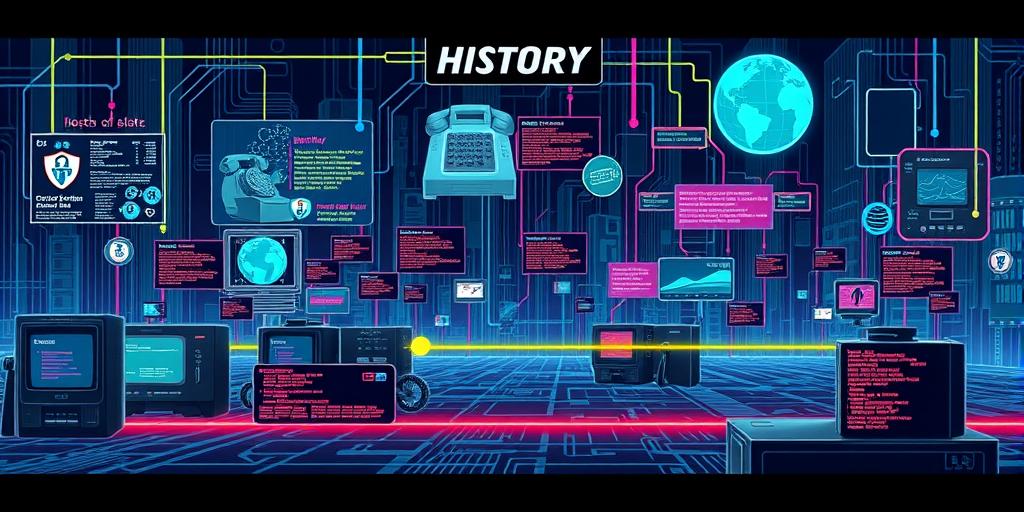A Look Back at the History of Cybersecurity Breaches
Have you ever wondered about the evolution of digital threats? From the earliest days of computing to the sophisticated cyberattacks of today, the history of cybersecurity breaches is a fascinating and often terrifying journey. This article delves into the most significant moments, revealing the trends, technologies, and vulnerabilities that have shaped the cybersecurity landscape we inhabit. Prepare to be amazed—and maybe a little scared—as we uncover the shocking truth about how far cybercrime has come!
The Early Days: When Hacking Was Just a Hobby
The early days of computing saw a relatively innocent form of hacking. Think of it as the Wild West of the digital frontier. Security wasn’t a major concern, and those with the knowledge and inclination could explore systems with relatively little consequence. The 1970s and 80s witnessed the rise of phone phreaking, where individuals exploited vulnerabilities in the telephone system to make free calls—a precursor to the more sophisticated attacks we see today. This era lacked the sophisticated malware and widespread connectivity we’re familiar with now, but it laid the groundwork for future exploits. Early examples of computer hacking often involved accessing mainframe systems for the thrill of the challenge, or to display skills and knowledge, rather than for malicious intent. The culture was one of shared knowledge and discovery, though this approach had its limitations. The concept of “responsible disclosure” – reporting security flaws to the developers without exploiting them – was only just beginning to form. It was a time of exploration and discovery that highlighted the growing need for better security practices, paving the way for the development of robust cybersecurity measures that we have now.
The Birth of Viruses
The emergence of computer viruses marked a turning point. These self-replicating programs could spread rapidly, infecting systems and causing disruption. Early viruses were often simple, causing minor annoyances like displaying messages or changing system settings. However, they demonstrated the potential for malicious actors to cause widespread damage. The development of anti-virus software became a necessity, starting a continuous arms race between attackers and defenders. One of the first well-known computer viruses, the “Creeper” virus, emerged in 1971. It was designed by Bob Thomas at BBN, and was an early demonstration of the potential for self-replicating programs that could spread across networks. While not malicious, Creeper helped pave the way for the emergence of more destructive viruses. These initial viruses were rather crude by today’s standards, but they signified a crucial shift in the threat landscape. We were no longer dealing solely with curious individuals exploring system vulnerabilities. The concept of malicious intent was firmly established in the world of digital technology.
The Rise of the Internet and Cybercrime
The proliferation of the internet in the 1990s dramatically expanded the potential for cybercrime. Suddenly, hackers had access to a vast network of interconnected systems, creating numerous opportunities for attacks. This period saw the rise of sophisticated malware, including worms and Trojans, capable of causing significant damage and stealing valuable data. The Internet Relay Chat (IRC) network played a significant role, providing a platform for hackers to communicate and share information. This rise in cybercrime highlighted the need for stronger security measures across all networks and systems. The increase in internet users also led to the growth in the number of potential victims, making it easier for cybercriminals to spread malware and target specific individuals or organizations.
The Dot-Com Bubble and the Rise of Financial Cybercrime
The dot-com bubble of the late 1990s saw a surge in online businesses and financial transactions. This created a new wave of targets for cybercriminals seeking to steal money and sensitive data. The lack of robust security measures in many early online businesses made them vulnerable to attacks. This also created a huge incentive for hackers to target these businesses, as the reward for a successful breach was significantly higher. The introduction of online banking and e-commerce changed the game for hackers and businesses alike. Hackers gained access to sensitive financial data which made identity theft and financial fraud become significantly more prevalent. The rise of online banking and e-commerce amplified the consequences of successful cyberattacks, leading to significant financial losses and reputational damage for affected companies.
The Modern Era: Sophisticated Attacks and Data Breaches
Today’s cybersecurity landscape is dominated by highly sophisticated attacks targeting individuals, businesses, and governments. Advanced persistent threats (APTs), ransomware attacks, and large-scale data breaches are commonplace. Cybercriminals are increasingly using artificial intelligence and machine learning to automate attacks and evade detection. The development of these highly advanced and organized cybercriminal networks has posed an unprecedented threat, requiring a more advanced and reactive approach to cybersecurity. The sheer scale and sophistication of modern attacks require a coordinated global effort to combat them effectively. Governments and private sector organizations are increasingly working together to share information and develop new security technologies. The rise of “big data” and the increased reliance on cloud computing also pose new challenges, requiring careful consideration of data security and privacy.
The Growing Threat of Ransomware
Ransomware attacks have become a major concern in recent years. These attacks involve encrypting a victim’s data and demanding a ransom for its release. The widespread use of ransomware highlights the critical importance of robust data backup and recovery plans. The financial and reputational impact of ransomware attacks can be devastating for businesses of all sizes. Furthermore, the potential for ransomware attacks to disrupt critical infrastructure services also poses a significant threat to national security and public safety. It’s not just about the financial loss, but also the downtime and reputational damage caused by a ransomware attack.
The Future of Cybersecurity
The future of cybersecurity will likely be defined by the ongoing arms race between attackers and defenders. New technologies such as quantum computing pose both opportunities and challenges, creating new vulnerabilities while also potentially enabling stronger security measures. The growing use of artificial intelligence and machine learning will likely lead to both more sophisticated attacks and more effective defenses. Governments and organizations must continue to invest in cybersecurity research and development to stay ahead of the curve. The future of cybersecurity will require a proactive and collaborative approach, with governments, businesses, and individuals working together to mitigate the risks. There is also a need for more stringent cybersecurity regulations and legislation to protect data and prevent cybercrime. International collaboration is key to effectively addressing the global nature of cybersecurity threats.
Protecting your data and systems has never been more crucial. Don’t wait until it’s too late! Take action today to safeguard your digital assets and stay ahead of the ever-evolving threat landscape.













